
Domḗnikos Theotokópoulos, most widely known as El Greco, was a Greek painter, sculptor and architect of the Spanish Renaissance. "El Greco" was a nickname, and the artist normally signed his paintings with his full birth name in Greek letters, Δομήνικος Θεοτοκόπουλος, often adding the word Κρής, which means Cretan.

The Thyssen-Bornemisza National Museum, or simply the Thyssen, is an art museum in Madrid, Spain, located near the Prado Museum on one of the city's main boulevards. It is known as part of the "Golden Triangle of Art", which also includes the Prado and the Reina Sofía national galleries. The Thyssen-Bornemisza fills the historical gaps in its counterparts' collections: in the Prado's case this includes Italian primitives and works from the English, Dutch and German schools, while in the case of the Reina Sofia it concerns Impressionists, Expressionists, and European and American paintings from the 20th century.

View of Toledo, is one of the two surviving landscapes painted by El Greco, along with View and Plan of Toledo. View of Toledo is held by the Metropolitan Museum of Art in New York City.
Events from the year 1614 in art.
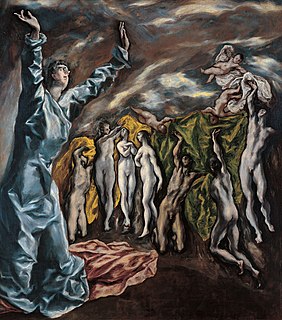
The Opening of the Fifth Seal was painted in the last years of El Greco's life for a side-altar of the church of Saint John the Baptist outside the walls of Toledo. Before 1908, El Greco's painting had been referred to as Profane Love. The scholar Manuel B. Cossio had doubts about the title and suggested the Opening of the Fifth Seal. The Metropolitan Museum, where the painting is kept, comments: "the picture is unfinished and much damaged and abraded."
El Greco (1541–1614) was a prominent painter, sculptor and architect active during the Spanish Renaissance. He developed into an artist so unique that he belongs to no conventional school. His dramatic and expressionistic style was met with puzzlement by his contemporaries but gained newfound appreciation in the 20th century.
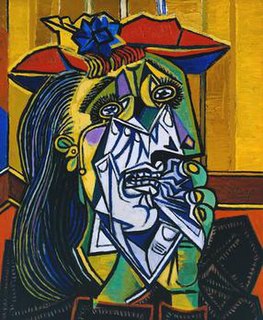
The Weeping Woman is a series of oil on canvas paintings by Pablo Picasso, the last of which was created in late 1937. The paintings depict Dora Maar, Picasso's mistress and muse. The Weeping Woman paintings were produced by Picasso in response to the bombing of Guernica in the Spanish Civil War and are closely associated with the iconography in his painting Guernica. Picasso was intrigued with the subject of the weeping woman, and revisited the theme numerous times that year. The last version, created on 26 October 1937, was the most elaborate of the series, and has been housed in the collection of the Tate Modern in London since 1987. Another Weeping Woman painting is housed at the National Gallery of Victoria and was involved in a high-profile political art theft.
Philip II of Spain has inspired artistic and cultural works for over four centuries, as the most powerful ruler in the Europe of his day, and subsequently a central figure in the "Black Legend" of Spanish power. The following list covers representations of him in drama, opera, film, novels, and verse. A small selection of the many artistic portrayals of Philip is shown in gallery form.

The Laocoön is an oil painting created between 1610 and 1614 by Greek painter El Greco. It is part of a collection at the National Gallery of Art in Washington, D.C.
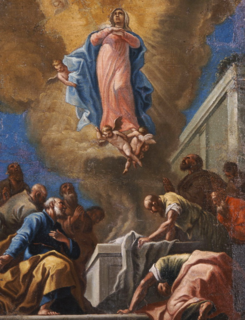
Nikolaos Doxaras. He was a Greek painter and teacher. His father was famous painter Panagiotis Doxaras. Panagiotis Doxaras was the father of the Greek Rococo and the Modern Greek Enlightenment in art. They are both prominent members of the Heptanese School. They refined Greek art bringing the Maniera Greca into the Maniera Italiana. Artists he influenced include: Nikolaos Kantounis, Nikolaos Koutouzis and Gerasimos Pitsamanos. His influence can be seen in some of Nikolaos Kantounis's paintings notably The Assumption. Nikolaos taught famous painter Nikolaos Koutouzis. Both Nikolaos Koutouzis and Doxaras artistic style refined the art of the Ionian Islands. Venetian painting influenced countless Greek artists who were living in the empire. From Michael Damaskinos to Theodore Poulakis. Twenty years after Nikolaos's death the style came to an end due to the Fall of the Republic of Venice. A new artistic style developed after the Greek Rococo which coincided with Neoclassicism in the rest of Europe called the middle Modern Greek Enlightenment in art also known as Neo-Hellenikos Diafotismos.

Saint Peter and Saint Paul is a painting by the Cretan-Spanish artist El Greco. The work was completed between 1590 and 1600. It is currently on display at the Museu Nacional d'Art de Catalunya, who purchased the work in 1932.

Saint Luke is a painting by an artist known as El Greco. The painting is an oil on canvas created sometime around 1610-1614. It is currently held by the Indianapolis Museum of Art in Indianapolis, Indiana.

The Museum of El Greco is located on the edge of the village of Fodele in Crete, west of the city of Heraklion. It celebrates the mannerist painter El Greco, who grew up in the village.

The El Greco Museum is located in Toledo, Spain. It celebrates the mannerist painter El Greco, who spent much of his life in Toledo, having been born in Fodele, Crete.

Saint Sebastian, or Martyrdom of Saint Sebastian is an autograph work by the famed artist Doménikos Theotokópoulos, commonly known as El Greco. It shows the Martyred Saint in an atypical kneeling posture which has led some scholars to believe it to be a compositional quotation of various works by other great masters whom the artist admired. The painting is currently on display in the Palencia Cathedral.
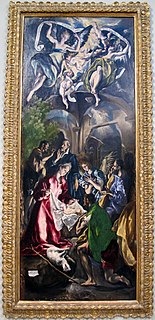
The Adoration of the Shepherds is a painting of the traditional subject which was painted by El Greco in 1596. It is in the European painting collection of the National Museum of Art of Romania. This unusually tall painting is a work in the group of equally tall paintings which the artist made as part of his 1596 commission known as the Doña María de Aragón Altarpiece for the Colegio de Dona Maria de Aragón in a building that is now the location of Palacio del Senado in Madrid. El Greco's signature, in Greek, may be seen on the paper in the lower left corner.

Last Supper is a 1568 painting by Greek painter sculptor and architect of the Spanish Renaissance Doménikos Theotokópoulos (1541–1614), most widely known as El Greco.
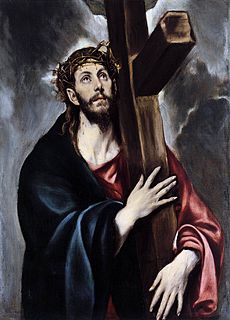
Christ Carrying the Cross is an oil painting by El Greco, produced early in his Toledo period circa de 1580. The picture depicts Christ in a moment of personal reflection as he carries the cross to his death, therefore committing the ultimate sacrifice for humankind. In the painting, Christ's eyes are lifted up to the heavens as he begins his walk towards his crucifixion. His gentle hands wrap around the cross as a stormy night floods the background. Christ Carrying the Cross is an oil painting, 105x79cm. The painting, one of numerous similar paintings by El Greco, is currently in the El Greco room in the New York art collection of the Metropolitan Museum of Art.

Baptism of Christ is a 1567-1569 painting by El Greco. It is now in the Historical Museum of Crete in Heraklion.
















